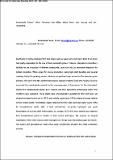Por favor, use este identificador para citar o enlazar a este item:
http://hdl.handle.net/10261/126014COMPARTIR / EXPORTAR:
 SHARE SHARE
 CORE
BASE CORE
BASE
|
|
| Visualizar otros formatos: MARC | Dublin Core | RDF | ORE | MODS | METS | DIDL | DATACITE | |

| Título: | Increased bioethanol production from commercial tobacco cultivars overexpressing thioredoxin f grown under field conditions |
Autor: | Farrán, Inmaculada CSIC ORCID ; Fernández San Millán, Alicia CSIC ORCID; Ancín, María CSIC ORCID ; Larraya, Luis; Veramendi, Jon CSIC ORCID | Palabras clave: | Tobacco Chloroplast transformation Thioredoxin Bioethanol Field trial Carbohydrates |
Fecha de publicación: | 13-feb-2014 | Editor: | Kluwer Academic Publishers | Citación: | Molecular Breeding 34(2): 457- 469 (2014) | Resumen: | Bioethanol is mainly produced from food crops such as sugar cane and maize, and this has been held partly responsible for the rise of food commodity prices. Tobacco, integrated in biorefinery facilities for the extraction of different compounds, could become an alternative feedstock for biofuel production. When grown for energy production, using high plant densities and several mowings during the growing season, tobacco can produce large amounts of inexpensive green biomass. We have bred two commercial tobacco cultivars (Virginia Gold and Havana 503B) to increase the carbohydrate content by the overexpression of thioredoxin f in the chloroplast. Marker-free transplastomic plants were recovered and their agronomic performance under field conditions was evaluated. These plants were phenotypically equivalent to their wild types yet showed increased starch (up to 280 %) and soluble sugar (up to 74 %) contents in leaves relative to their control plants. Fermentable sugars released from the stalk were also higher (up to 24 %) for transplastomic plants. After heat pretreatment, enzymatic hydrolysis and yeast fermentation of leaf and stalk hydrolysates, an average of 20¿40 % more ethanol was obtained from transplastomic plants than their wild-type controls. We propose an integral exploitation of the entire tobacco plant managed as a forage crop (harvesting sugar and starch-rich leaves and lignocellulosic stalks) that could considerably cheapen the entire production process. | Versión del editor: | http://dx.doi.org/10.1007/s11032-014-0047-x | URI: | http://hdl.handle.net/10261/126014 | DOI: | 10.1007/s11032-014-0047-x | Identificadores: | issn: 1572-9788 |
| Aparece en las colecciones: | (IDAB) Artículos |
Ficheros en este ítem:
| Fichero | Descripción | Tamaño | Formato | |
|---|---|---|---|---|
| Post-print_Farran_2015_MOLB.pdf | 404,4 kB | Adobe PDF |  Visualizar/Abrir |
CORE Recommender
SCOPUSTM
Citations
10
checked on 22-abr-2024
WEB OF SCIENCETM
Citations
10
checked on 19-feb-2024
Page view(s)
372
checked on 24-abr-2024
Download(s)
587
checked on 24-abr-2024
Google ScholarTM
Check
Altmetric
Altmetric
NOTA: Los ítems de Digital.CSIC están protegidos por copyright, con todos los derechos reservados, a menos que se indique lo contrario.
